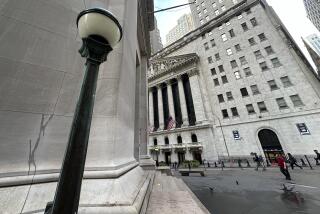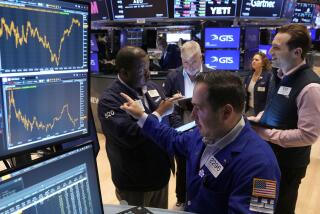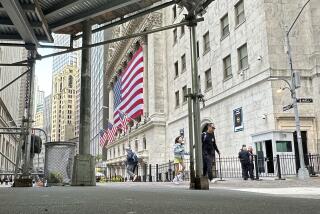STOCKS : Late Computer Trading Adds 34.41 to Dow
A late burst of buying Wednesday ignited a snap recovery on Wall Street that sent blue chip stocks up nearly 35 points.
“We got hit with a bunch of (computer-trading) programs going into the finish,” said Robert Walberg, an analyst at MMS International. “People waiting for a correction were forced to come in.”
The Dow Jones industrial average closed 34.41 points higher at 2,909.16. Earlier, the 30-share Dow was down as much as 12 points as investors pocketed profits from the market’s recent 160-point rally.
The Dow close was the highest point since July 30, when the Dow average closed at 2,917.33.
Meanwhile, the Standard & Poor’s 500 index--a broad market indicator--rose 3.52 to a record high of 369.02, edging out the old benchmark close of 368.95 set July 16, 1990.
The NYSE Composite Index ended 1.75 points higher at 201.18, also a new closing high. The former high was made July 16, 1990, at 201.13.
“It’s unbelievable. It happened all of a sudden,” said Edward Shopkorn, general partner in charge of institutional equities at Mabon Nugent.
New York Stock Exchange volume slowed to a still hefty 209.96 million shares from 256.16 million Tuesday. In the broader market, advancing issues outnumbered declines by nearly 2-to-1 in nationwide trading of New York Stock Exchange-listed stocks, with 1,042 up, 558 down and 441 unchanged.
“In my opinion, I see almost no sign of a short-term top,” said Alfred Goldman, director of technical research at A. G. Edwards. “I see too much momentum.”
The prospect of more U.S. interest rate cuts will fuel further stock price gains, he said.
“The Federal Reserve has made it clear that they’re going to do whatever it takes to turn the economy around,” Goldman said.
Among the market highlights:
* Many industrial stocks led the market higher, resuming their rally on expectations of a mild recession. Alcoa leaped 3 to 69 3/4, GE added 1 to 67 3/4, 3M Co. rose 2 1/2 to 93 1/4 and Dow Chemical was up 1 1/2 to 55 5/8. Cummins Engine, however, lost 2 1/4 to 41 7/8 after Industrial Equity Pacific said it sold its 8.1% stake in Cummins.
* Tech stocks rebounded. IBM rose 1 7/8 to 134 5/8, Motorola soared 3 3/4 to 61, Wyle Labs jumped 1 to 14 7/8, software firm MacNeal Schwendler added 3/4 to 15 3/8 and personal computer firm Tandon gained 3/16 to 3 7/8.
* Santa Ana-based Microsemi rocketed 7/16 to 1 11/16 on a positive earnings report. But software retailer Egghead plunged 3 3/4 to 12 1/4 after reporting slowing growth in same-store sales in its third quarter.
* Entertainment and media stocks gained. Time Warner jumped 5 1/2 to 115 1/2 on continuing rumors that it plans to sell a stake in some of its entertainment operations to foreign partners. Elsewhere, Disney rose 1 7/8 to 121 5/8, Cap Cities gained 15 to 495 and Pathe jumped 1/2 to 3 3/4.
* Paramount was flat at 44 5/8 as Kidder Peabody downgraded the stock to hold from buy, citing fears of near-term earnings disappointments. Orion slipped 3/8 to 9 5/8 one day after Moody’s cut the firm’s debt ratings.
* Many health-care stocks strengthened anew, including Southland medical-device companies Mentor Corp., up 1 to 20 5/8, and Trimedyne, up 1 1/4 to 5 3/4. Also, Thousand Oaks-based biotechnology giant Amgen rebounded 2 3/4 to 81 and Fountain Valley-based health-maintenance firm FHP International jumped 1 1/4 to 19 3/4.
In foreign trading, stocks closed higher in Tokyo, ending above the 25,000 point barrier for the first time since Oct. 31 of last year. The 225-share Nikkei average climbed 204.46, closing at 25,139.47.
German share prices closed higher, buoyed by strong bond prices and hints from Iraq that it might be willing to agree to an end to the Persian Gulf War. The 30-share DAX index rose 20.47 to 1,489.41.
In London, stocks finished with modest gains but below the day’s highs, as an early rally ignited by a cut in money lending rates fizzled. The Financial Times 100-share average closed up 3.3 at 2,267.8.
Credit
Government securities prices were little changed in dull trading as the market awaited the release of economic data later this week.
The price of the Treasury’s bellwether 30-year bond, unchanged Tuesday, rose 1/16 point, or about 62 cents per $1,000 in face value. The bond’s yield edged down to 7.95% from late Tuesday’s 7.96%.
In the day’s only piece of significant market news, the government said January retail sales dropped 0.9%.
The drop was significantly less than the 1.5% decline expected by most economists and thus not sharp enough to persuade traders that the Federal Reserve might take quick action to lower interest rates, which would push up bond prices.
The federal funds rate, the interest on overnight loans between banks, was quoted at 6.125%, up from 5.75% late Tuesday, when technical factors pushed the rate downward.
Currency
The dollar advanced on foreign exchange markets, boosted by a British interest rate drop and by signals that the major industrial nations don’t want the U.S. currency to decline.
The decline in British interest rates and an expected cut in Japanese rates helped send the dollar higher, said Robert Ryan, corporate foreign exchange manager with Bank of New York.
Bank of England cut its base rate by 0.5% to 13.5%, making the pound a less attractive investment. All currencies are supported by higher rates in their home countries and lower rates abroad, so a drop in British yields is a positive sign for the dollar.
Analysts said the dollar was also aided by comments by U.S. and Japanese monetary officials that the Group of Seven industrial nations don’t want to see the dollar fall further after its recent slide.
Treasury Undersecretary Charles H. Dallara said in a speech Wednesday that the United States does not want a lower dollar, while Bank of Japan Governor Yasushi Mieno said earlier that the G-7 would take coordinated steps to counter a sharp decline in the dollar.
Central bank intervention Tuesday on behalf of the dollar also helped the U.S. currency Wednesday.
The combination of these factors “tilted the balance in favor of the dollar for the time being,” Ryan said.
In New York, the dollar ended at 1.4639 German marks, up from 1.4542 at Tuesday’s close. It also finished at 129.67 Japanese yen, up from Tuesday’s 128.65.
The British pound fell to $1.9840 in New York from late Tuesday’s $1.9910.
Other late dollar rates in New York, compared to late Tuesday’s prices, included: 1.2530 Swiss francs, up from 1.2460; 4.9875 French francs, up from 4.9565; 1,100.75 Italian lire, up from 1,094.75; and 1.15365 Canadian dollars, up from 1.15355.
Commodities
Prices of coffee futures leaped higher in heavy trading on New York’s Coffee, Sugar and Cocoa Exchange amid mounting worries about the availability of Brazilian and Central American beans.
On other commodity markets, orange juice futures rose sharply; oil futures fell; precious metals were mixed; grains and soybeans were higher, and livestock and meat futures were mixed.
Coffee settled 3.1 to 4 cents higher, with the contract for delivery in March at 91.20 cents a pound, a two-month high.
Light sweet crude oil finished 37 to 41 cents higher, with March at $22.56 a barrel, and heating oil was 0.05 cent to 3.69 cents lower, with March at 67.11 cents a gallon.
Gold was 80 cents to $1 lower, with February at $367.20 an ounce; silver was 3.8 to 4.4 cents higher, with March at $3.753 an ounce.
Market Roundup, D6
More to Read
Inside the business of entertainment
The Wide Shot brings you news, analysis and insights on everything from streaming wars to production — and what it all means for the future.
You may occasionally receive promotional content from the Los Angeles Times.










